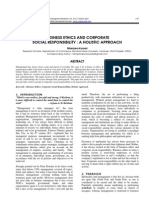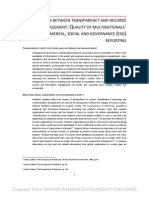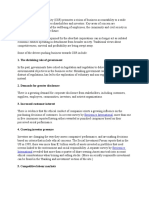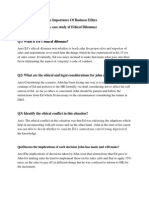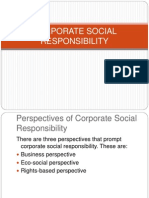Corporate Social Responsibility For Sustainable Business
Corporate Social Responsibility For Sustainable Business
Uploaded by
IOSRjournalCopyright:
Available Formats
Corporate Social Responsibility For Sustainable Business
Corporate Social Responsibility For Sustainable Business
Uploaded by
IOSRjournalOriginal Description:
Original Title
Copyright
Available Formats
Share this document
Did you find this document useful?
Is this content inappropriate?
Copyright:
Available Formats
Corporate Social Responsibility For Sustainable Business
Corporate Social Responsibility For Sustainable Business
Uploaded by
IOSRjournalCopyright:
Available Formats
IOSR Journal of Business and Management (IOSR-JBM)
e-ISSN: 2278-487X, p-ISSN: 2319-7668. Volume 17, Issue 5.Ver. I (May. 2015), PP 94-106
www.iosrjournals.org
Corporate Social Responsibility for sustainable business
Sendil Mourougan1
1
(Business Administration, Annamalai University, India)
Abstract : Corporate social responsibility (CSR) refers to strategies corporations or firms conduct their
business in a way that is ethical, society friendly and beneficial to community in terms of development. This
article examines the meaning of CSR based on three theories namely utilitarian, managerial and relational
theories. It discusses the different phases of CSR development in India, CSR dimensions, CSR drivers and Key
international CSR instruments. This paper details the steps in formalizing CSR projects, cost involved and its
implementation, measurement and sustainability. It also explores the role of CSR in community development
and competencies required by CSR managers to have a better understanding of the practical aspects of CSR.
Keywords: Corporate Social Responsibility, CSR Theories, CSR development, CSR benefits, CSR dimensions,
CSR drivers, Clause 135 Companies Act 2013, CSR strategy, CSR measurement, CSR costs, CSR instruments,
Stakeholder engagement, CSR implementation, CSR sustainability.
I.
Introduction
There is growing recognition of the significant effect the activities of the private sector haveon
employees, customers, communities, the environment, competitors, business partners, investors, shareholders,
governments and others. It is also becoming increasingly clear that firms can contribute to their own wealth and
to overall societal wealth by considering the effect they have on the world at large when making decisions.
Business opinion polls and corporate behaviour both show increased levels of understanding of the link
between responsible business and good business. Also, investors and financial markets are beginning to see that
CSR activities that integrate broader societal concerns into business strategy and performance are evidence of
good management. In addition to building trust with the community and giving firms an edge in attracting good
customers and employees, acting responsibly towards workers and others in society can help build value for
firms and their shareholders.
II.
Corporate Social Responsibility
Corporate social responsibility (CSR) is also known by a number of other names. These include
corporate responsibility, corporate accountability, corporate ethics, corporate citizenship or stewardship,
responsible entrepreneurship, and triple bottom line, to name just a few. As CSR issues become increasingly
integrated into modern business practices, there is a trend towards referring to it as responsible
competitiveness or corporate sustainability.
A key point to note is that CSR is an evolving concept that currently does not have a universally
accepted definition. Generally, CSR is understood to be the way firms integrate social, environmental and
economic concerns into their values, culture, decision making, strategy and operations in a transparent and
accountable manner and thereby establish better practices within the firm, create wealth and improve society. As
issues of sustainable development become more important, the question of how the business sector addresses
them is also becoming an element of CSR.
2.1 Importance of Corporate Responsibility
The most important aspects of CR to the company
Ethical behaviour on the part of all staff
High standards of CR
Transparency in corporate dealings
Labour practices and employee rights
Environmental practices
Equitable pricing and remuneration policies
Philanthropy and charitable giving
Ethical investments
Higher employee morale and commitment
Enhancement of the brand with customers
Better relations with governments, local communities
Competitive advantage over rivals
DOI: 10.9790/487X-175194106
www.iosrjournals.org
94 | Page
Corporate Social Responsibility for sustainable business
Reduced likelihood of regulatory intervention
2.2 Theories of CSR
Secchi has come up with a group of theories based on a criterion what role the theories confer to the
corporation and society. The theories as shown in Table 1 are: 1) The utilitarian theory, 2) The managerial
theory, and 3) The relational theory. On the other hand, Garriga and Meles (2004) analysis, maps CSR into four
types of theories as shown in Table 2. They are: 1) Instrumental theories, 2) Political theories, 3) Integrative
theories, and 4) Ethical theories.
Table 1. Utilitarian, managerial and relational theories of CSR
Utilitarian Theory
Theories on social costs
Functionalism
Managerial Theory
Relational Theory
Corporate social performance
Social accountability, auditing and reporting
(SAAR)
Social responsibility for multinationals
Business and society stakeholder approach
Corporate global citizenship
Social contract theory
Table 2. Corporate social responsibilities theories and related approaches
Types of theory
Approaches
Instrumental theories
(Focusing on achieving economic
objectives through social activities)
Political theories
(focusing on a responsible use of
business power in the political
arena)
Short description
Maximization of shareholder
value
Strategies for competitive
advantage
Cause-related marketing
Long term value of maximization
Social investment in a competitive context
Firms view on natural resources and its dynamic
capabilities
Altruistic activities socially recognized as
marketing tool
Corporate constitutionalism
Integrative social contract
Corporate citizenship
Integrative theories
Ethical theories
(Focusing on the right thing to
achieve a good society)
Management issues
Public responsibility
Stakeholder management
Corporate social performance
Stakeholder normative theory
Universal rights
Sustainable development
The common good
Social responsibilities of businesses arise from the
social power the firms have
Assumes that a social contract between business and
society exists
The firm is understood as being like a citizen with
certain involvement in the community
Corporate response to social and political issues
Law and the existing public policy process are taken
as a reference for social performance
Balances the interests of firms stakeholders
Searches for social legitimacy and processes to give
appropriate responses to social issues
Considers fiduciary duties towards stakeholders of
the firm. This requires some moral theories
Based on human rights, labor rights and respect for
environment
Aimed at achieving human development
considering present and future generations
Oriented towards the common good of society
2.3 Factors leading to increasing attention of CSR
Many factors and influences have led to increasing attention being devoted to the role of companies and
CSR. These include:
Sustainable development: Many studies have underlined the fact that human kind is using natural
resources at a faster rate than they are being replaced. If this continues, future generations will not have the
resources they need for their development. CSR is an entry point for understanding sustainable
development issues and responding to them in a firms business strategy.
Globalization: CSR can play a vital role in detecting how business impacts labour conditions, local
communities and economies, and what steps can be taken to ensure business helps to maintain and build the
public good. This can be especially important for export-oriented firms in emerging economies.
Governance: Governments and intergovernmental bodies, such as the UN, the Organisation for Economic
Co-operation and Development (OECD) and the International Labour Organization (ILO) have developed
various compacts, declarations, guidelines, principles and other instruments that outline norms for what
they consider to be acceptable business conduct. CSR instruments often reflect internationally-agreed goals
and laws regarding human rights, the environment and anti-corruption.
Corporate sector impact: Companies are global ambassadors of change and values. How they behave is
becoming a matter of increasing interest and importance
DOI: 10.9790/487X-175194106
www.iosrjournals.org
95 | Page
Corporate Social Responsibility for sustainable business
Communications: Advances in communications technology, such as the Internet and mobile phones, are
making it easier to track and discuss corporate activities. In the CSR context, modern communications
technology offers opportunities to improve dialogue and partnerships.
Finance: Consumers and investors are demanding more information on how companies are addressing risks
and opportunities related to social and environmental issues. A sound CSR approach can help build share
value, lower the cost of capital, and ensure better responsiveness to markets.
Ethics: A number of serious and high-profile breaches of corporate ethics resulting in damage to
employees, shareholders, communities or the environmentas well as share pricehave contributed to
elevated public mistrust of corporations. A CSR approach can help improve corporate governance,
transparency, accountability and ethical standards.
Consistency and Community: Citizens in many countries are making it clear that corporations should
meet the same high standards of social and environmental care. In the CSR context, firms can help build a
sense of community and shared approach to common problems.
Business Tool: Businesses are recognizing that adopting an effective approach to CSR can reduce the risk
of business disruptions, open up new opportunities, drive innovation, enhance brand and company
reputation and even improve efficiency.
2.4 Four phases of CSR development in India
The history of Corporate Social Responsibility in India has its four phases which run parallel to India's
historical development and has resulted in different approaches towards Corporate Social Responsibility.
However the phases are not static and the features of each phase may overlap other phases.
2.4.1 The first phase
In the first phase charity and philanthropy were the main drivers of Corporate Social Responsibility.
Culture, religion, family values and tradition and industrialization had an influential effect on Corporate Social
Responsibility. In the pre-industrialization period, which lasted till 1850, wealthy merchants shared a part of
their wealth with the wider society by way of setting up temples for a religious cause. With the arrival of
colonial rule in India from 1850s onwards, the approach towards Corporate Social Responsibility changed. The
industrial families of the 19th century such as Tata, Godrej, Bajaj, Birla, Singhania were strongly inclined
towards economic as well as social considerations. However it has been observed that their efforts towards
social as well as industrial development were not only driven by selfless and religious motives but also
influenced by caste groups and political objectives.
2.4.2 The second phase
In the second phase, during the Independence movement, there was increased stress on Indian
Industrialists to demonstrate their dedication towards the progress of the society. According to Gandhi, Indian
companies were supposed to be the "temples of modern India". Under his influence businesses established trusts
for schools and colleges and also helped in setting up training and scientific institutions. The operations of the
trusts were largely in line with Gandhi's reforms which sought to abolish untouchability, encourage
empowerment of women and rural development.
2.4.3 The third phase
The third phase of Corporate Social Responsibility (196080) had its relation to the element of "mixed
economy", emergence of Public Sector Undertaking and laws relating labor and environmental standards.
During this period the private sector was forced to take a backseat. The public sector was seen as the prime
mover of development. Because of the stringent legal rules and regulations surrounding the activities of the
private sector, the period was described as an "era of command and control".
2.4.4 The fourth phase
In the fourth phase (1980 until the present) Indian companies started abandoning their traditional
engagement with CSR and integrated it into a sustainable business strategy. In 1990s the first initiation towards
Globalizations and Economic Liberalization were undertaken. Controls and licensing system were partly done
away with which gave a boost to the economy the signs of which are very evident today. Increased growth
momentum of the economy helped Indian companies grow rapidly and this made them more willing.
Globalization has transformed India into an important destination in terms of production and manufacturing
bases. As Western markets are becoming more and more concerned about and labour and environmental
standards in the developing countries, Indian companies who export and produce goods for the developed world
need to pay a close attention to compliance with the international standards.
DOI: 10.9790/487X-175194106
www.iosrjournals.org
96 | Page
Corporate Social Responsibility for sustainable business
2.5 Benefits of implementing a CSR approach
No matter the size of an organization or the level of its involvement with Corporate Social
Responsibility every contribution is important and provides a number of benefits to both the community and
business. Contributing to and supporting Corporate Social Responsibility does not have to be costly or time
consuming and more and more businesses active in their local communities are seeing significant benefits from
their involvement. Some of the positive outcomes that can arise when businesses adopt a policy of social
responsibility include:
Company benefits
Improved financial performance;
Lower operating costs;
Enhanced brand image and reputation;
Increased sales and customer loyalty;
Greater productivity and quality;
More ability to attract and retain employees;
Reduced regulatory oversight;
Access to capital;
Workforce diversity;
Product safety and decreased liability.
Increased business leads
Increased staff morale and skills development
Innovation in processes, products and services
Managing the risks a company faces
Benefits to the community and the general public
Charitable contributions;
Improved relationships with the local community, partners and clients
Employee volunteer programmes;
Corporate involvement in community education, employment and homelessness programmes;
Product safety and quality.
Environmental benefits
Greater material recyclability;
Better product durability and functionality;
Greater use of renewable resources;
Integration of environmental management tools into business plans, including life-cycle assessment and
costing, environmental management standards, and eco-labelling.
2.6 Role of CSR in Community Development
The role of CSR in CD used in this paper is any direct and indirect benefits received by the community as
results of social commitment of corporations to the overall community and social system. The common roles of
CSR in CD are as follows:
1. To share the negative consequences as a result of industrialization..
2. Closer ties between corporations and community.
3. Helping to get talents.
4. Role in transfer of technology (TOT).
5. CSR helps to protect environment.
6. CSR is for human right corporate sustainability.
7. Interdependency between a corporation and community.
8. A CSR program can be seen as an aid to alleviate poverty.
9. A CSR program helps in data gathering for other public organization function.
2.7 Skills Needed by CSR Managers in Community Development
The success of CSR is determined by both internal and external factors. Internal factors are economic
considerations, culture of the firm including the CEO and employees, and ethical influences; while external
factors are compliance with legal requirements and technological influences as well as national culture. Skills
possessed by CSR managers are among the internal factors determining the success of CSR practices especially
in helping community. Because CSR profession is so new, transferable skills and knowledge from other related
DOI: 10.9790/487X-175194106
www.iosrjournals.org
97 | Page
Corporate Social Responsibility for sustainable business
specialization such as environmental management, business ethics, community development, and human
resource development are valuable.
Specific skills for CSR managers are very hard to clarify due to the diverse roles and range of disciplines
involved. Three main areas of skills are relevant. They are Business skills, People skills and Technical skills.
Business skills include building insight, communication skills, decision making, commercial awareness,
information technology, innovation, strategic awareness, leadership and problem solving.
People skills cover adaptability and empathy, developing others in the community, influencing without
power, integrity, political awareness, altruism, volunteerism, and adult learning.
Technical skills include technical expertise, understanding evaluation and impacts, stakeholder dialogue,
human rights and understanding sustainability.
Based on the above skills grouping, CSR managers should have six core competencies. They are
understanding community and community development, building capacity, questioning business beyond profit
making, stakeholder relations, strategic business and community partnership, and harnessing diversity. Hence,
CSR managers have a wide range of career options such as in marketing, human resources, health and safety,
environmental management, ethical investment, public relations, ethical science, community resource
development and social research.
2.8 CSR drivers
The key drivers for CSR are:
Enlightened self-interest: creating a synergy of ethics, a cohesive society and a sustainable global
economy where markets, labour and communities are able to function well together.
Social investment: contributing to physical infrastructure and social capital is increasingly seen as a
necessary part of doing business.
Transparency and trust: business has low ratings of trust in public perception. There is increasing
expectation that companies will be more open, more accountable and be prepared to report publicly on their
performance in social and environmental arenas
Increased public expectations of business: globally companies are expected to do more than merely
provide jobs and contribute to the economy through taxes and employment.
2.9 Costs of CSR
To compile an overview of costs associated with CSR, the first step is to identify which CSR-related
activities have been undertaken, and the second step is to estimate the costs related to these activities. Costs can
be separated into opportunity costs, sunk costs and recurrent costs as shown in Table 3. The costs of doing CSR
vary depending on the CSR subject. Generally speaking, environment-related CSR activities mainly cause costs
in terms of capital (e.g. new equipment, improvement of energy use etc.) and minor recurrent costs (such as
equipment update and maintenance). In contrast, recurrent costs of CSR activities aimed at improving social
aspects of business operations often exceed capital costs.
In addition to costs for the actual CSR implementation, showing credible proof of good CSR
performance to consumers or trade partners through auditing and certification based on buyer companies codes
of conduct or internationally recognized voluntary sustainability standards can also incur considerable costs.
Table 3: Costs of CSR
Costs of CSR
Sunk costs
Costs for investment in equipment, buildings, systems, infrastructure, consultancy, costs for CSR policy development etc.
Recurrent costs
Ongoing costs for wages, overtime payments, management time, social insurance, trainings, benefits for workers, equipment update and
maintenance, monitoring and reporting
Opportunity costs
Any projects that could not have been undertaken because labour and capital was invested in CSR activities or interest rate on bound
investment
2.10 CSR dimensions
There are six key responsibilities or dimensions of corporate social responsibility as shown in Figure 1.
CSR is really about how to manage these six responsibilities.
DOI: 10.9790/487X-175194106
www.iosrjournals.org
98 | Page
Corporate Social Responsibility for sustainable business
Figure 1. Key dimensions of CSR
III.
Clause 135, Companies Act, 2013
In India, the concept of CSR is governed by clause 135 of the Companies Act, 2013, which was passed
by both Houses of the Parliament, and had received the assent of the President of India on 29 August 2013. The
CSR provisions within the Act is applicable to companies with an annual turnover of 1,000 crore INR and more,
or a net worth of 500 crores INR and more, or a net profit of five crore INR and more. The new rules, which will
be applicable from the fiscal year 2014-15 onwards, also require companies to set-up a CSR committee
consisting of their board members, including at least one independent director.
The Act encourages companies to spend at least 2% of their average net profit in the previous three
years on CSR activities. The ministrys draft rules, that have been put up for public comment, define net profit
as the profit before tax as per the books of accounts, excluding profits arising from branches outside India.
The Act lists out a set of activities eligible under CSR. Companies may implement these activities
taking into account the local conditions after seeking board approval. The indicative activities which can be
undertaken by a company under CSR have been specified under Schedule VII of the Act.
Clause 135 of the Act lays down the guidelines to be followed by companies while developing their CSR
programme. The company can implement its CSR activities through the following methods:
Directly on its own
Through its own non-profit foundation set- up so as to facilitate this initiative
Through independently registered non-profit organisations that have a record of at least three years in
similar such related activities
Collaborating or pooling their resources with other companies
The CSR committee will be responsible for preparing a detailed plan on CSR activities, including the
expenditure, the type of activities, roles and responsibilities of various stakeholders and a monitoring
mechanism for such activities as shown in Table 4. The CSR committee can also ensure that all the kinds of
income accrued to the company by way of CSR activities should be credited back to the community.
The new Act requires that the board of the company shall, after taking into account the
recommendations made by the CSR committee, approve the CSR policy for the company and disclose its
contents in their report and also publish the details on the companys official website, if any, in such manner as
may be prescribed. If the company fails to spend the prescribed amount, the board, in its report, shall specify the
reasons.
DOI: 10.9790/487X-175194106
www.iosrjournals.org
99 | Page
Corporate Social Responsibility for sustainable business
Table 4. Step towards formalizing CSR projects
Objective
Process owners
Inputs
Step 1: Developing a CSR strategy and policy
Developing the CSR
CSR committee
Guidance from the board
strategy and policy
Companies Act requirements
Corporate business strategy, plan and
supply chain
Development priorities
Step 2: Operationalising the institutional mechanism
Establishing a legal
CSR committee
CSR strategy
entity and aligning the
accounting, tax, finance,
administration, HR and
IT systems to deliver the
commitments made in
the CSR policy
the CSR policy
institutional mechanisms
information from the government
sources, previous studies done in the
area, etc
information on programs targeting
similar geographies and beneficiary
groups or strategies
monitoring impact measurement
reports from any earlier projects
Step 5: Project approval
Approve the project
CSR committee or a project proposal
based on the CSR policy the delegated
a due diligence report
objectives, principles
project approval
and guidelines
committee.
Step 6: Finalising the arrangement with the implementing agency
Agree upon and sign the
CSR committee
approved project proposal
MoU with the partner
due diligence report
Step 7: Progress monitoring and reporting
Monitoring progress,
The CSR
approved project proposal
distilling lessons and
committee
previous monitoring reports
forming the basis for
reporting.
Step 8: Impact measurement
Measuring the projects
The CSR
resource planning
outcome and impact
committee
project MoU
Step 9: Report consolidation and communication
Reporting the CSR at an
The CSR
CSR strategy and policy
individual project level,
department
the project MoU
aligned with the
monitoring reports from individual
requirements under the
projects
Companies Act, 2013
and the CSR committee.
IV.
The CSR policy document and an indication
of sectors and issues, geographies and a
profile of the beneficiaries.
Creation of a separate legal entity or a CSR
department for CSR activities
Other institutional mechanisms to align the
accounting, finance, administration, HR and IT
systems with CSR activities
Step 3: Due diligence of the implementation partner
Selecting the
CSR department
CSR strategy and policy
implementation partner
or Company
discussions with communities,
Foundation
board, staff, other funders, local
government officials, local leaders or
influencers, auditors
studying the accounts books and
auditors report
Step 4: Project development
Developing a feasible
The
project proposal
implementation
agency (the CSR
department,
company
foundation or the
NGO partner)
Output(s)
a due diligence report
A project proposal that details:
a project context including the roles of other
development actors
key needs of the target beneficiaries
project goals, KPIs, baselines & deadlines
project milestones dates
activities and timelines to achieve the stated
project goals
budgets along with the basis for estimation
risks and mitigation strategies
progress reporting: content, frequency
An approved project proposal including a
monitoring process and reporting and
responsibility for this.
MoU with the implementing agency including
the disbursement schedule.
Determining mid-course corrections
Recommendations for future project designs
Project monitoring reports to the CSR
committee
impact measurement report
recommendations for future project designs
consolidated CSR reports
external stakeholder communication
Key international CSR instruments
The Global Compact asks companies to embrace, support and enact, within their sphere of influence, a
set of core values in the areas of human rights, labour standards, the environment and anti-corruption.
Human Rights
Principle 1 Businesses should support and respect the protection of internationally proclaimed human
rights; and
DOI: 10.9790/487X-175194106
www.iosrjournals.org
100 | Page
Corporate Social Responsibility for sustainable business
Principle 2 Make sure that they are not complicit in human rights abuses.
Labour Standards
Principle 3 Businesses should uphold the freedom of association and the effective recognition of the right to
collective bargaining;
Principle 4 The elimination of all forms of forced and compulsory labour;
Principle 5 The effective abolition of child labour; and
Principle 6 The elimination of discrimination in respect of employment and occupation.
Environment
Principle 7 Businesses should support a precautionary approach to environmental challenges;
Principle 8 Undertake initiatives to promote greater environmental responsibility; and
Principle 9 Encourage the development and diffusion of environmentally friendly technologies.
Anti-corruption
Principle 10 Businesses should work against all forms of corruption, including extortion and bribery.
V.
Non-governmental CSR-related codes and standards initiatives
The following are Non-governmental CSR-related codes and standards initiatives
Accountability standards: The AA1000 Series are principles based standards intended to provide the basis
for improving the sustainability performance of organizations.
Australian standard on compliance programs: Standards Australia developed AS 38061998 to help
firms ensure they have effective compliance programs in place. The standard includes structural,
operational and maintenance elements. Structural elements focus on commitments, compliance policies,
management responsibility, resources and continuous improvement.
British Standard on Sustainability Management, BS 8900: The British Standard is designed to provide a
structured approach to sustainable development by considering the social, environmental and economic
impacts of their organizations activities; be applicable to all organizations in terms of size, type, etc., It
makes it easier for organizations to adjust to changing social expectations; help organizations connect
existing technical, social and environmental standards.
Global Reporting Initiative (GRI) Sustainability Reporting Guidelines: The Global Reporting Initiative
develops and disseminates globally applicable sustainability reporting guidelines. These guidelines are for
the voluntary use. Organizations report on the economic, environmental and social dimensions of their
activities, products and services. Sector-specific guidelines are developed as interest is expressed. GRI
incorporates the active participation of representatives from business, accountancy, investment,
environmental, human rights, and research and labour organizations from around the world.
ISO 14001: ISO 14001 is a standard that provides a structure (an environmental management system or
EMS) to help organizations manage and minimize their environmental impacts and achieve continual
improvement.
ISO 9001: ISO 9001 is a standard that provides a structure (a quality management system) to help
organizations develop products and services that consistently ensure customer satisfaction and continuously
improve their products, services and process. The standard uses the plan, do, check and improve
approach.
OHSAS 18001: Occupational Health and Safety. OHSAS 18001 is a standard that provides a structure to
help organizations manage their occupational health and safety programs to ensure employee safety and
well-being and achieve continuous improvement. It is based on the British Standards Institution standard
BS 8800, and was developed by 13 national standards organizations and international certification bodies. It
is said to be compatible with ISO 9001 and ISO 14001.
ISO 26000: ISO framework on a new International Standard on Social Responsibility. It is expected to
provide a definition on what is understood by the term social responsibility and how organizations of all
kinds might go about responding to social responsibility issues and opportunities.
VI.
CSR Implementation
Companies face challenges and limitations as they implement CSR. These usually relate either to
political issues or to organizational-level concerns and are often embedded in culture. The complexity of
operating in a global society places new demands on organizations and their leadership. The biggest challenge in
the field of CSR implementation to be the development of leaders for a sustainable global society, asking what
kind of leader is needed for building a sustainable global society and how we can best develop individuals with
DOI: 10.9790/487X-175194106
www.iosrjournals.org
101 | Page
Corporate Social Responsibility for sustainable business
these leadership capabilities. The task and challenge will be to develop leaders for a sustainable global society
by encouraging imagination and the accomplishment of a positive change.
The role of the leader in guiding business toward sustainable social responsibility is complex and vast.
Responsible leaders are defined as people of the highest integrity and deep understanding of difficult concepts
such as sustainable development, committed to building enduring organizations in association with others,
leaders who have a deep sense of purpose and are true to their core values. Leaders of socially responsible
organizations have been associated with the charismatic leadership style; the connection between top managers
and firm outcomes depends to a large extent on the managers charismatic leadership under conditions of
perceived environmental uncertainty.
Charismatic leadership style communicates an innovation vision, energizes others to innovate, and
accelerates innovation processes and CSR; interactive leadership characteristically empowers employees to
innovate and to become innovation leaders themselves. The transformational leader is able to communicate so
enthusiastically that the result is pulling people to commit to the vision of the leader on sustainability. Some
effective organizational models for CSR, however, support a simultaneous transformational and visionary
leadership style, together with a need for transparency.
Moreover, CEOs intellectual stimulation is found to be significantly associated with the propensity of
the firm to engage in strategic CSR, or those CSR activities that are most likely to be related to the firms
corporate and business-level strategies. Leadership competencies consistent with responsible leaders include
courage, business acumen, passion, having a life (you cant think out of the box if you are always in the box),
compassion, sense of humor, and vision for legacy (instead of vision for activity). A leader should be
remembered as a person who designed a society that is educated, environmentally friendly, safe, and
economically sustainable.
Sample CSR checklist
A sample CSR checklist can be as shown below:
Provide a safer working environment and educational assistance to employees?
Improve contractual relations with employees?
Enhance gender equality in the workplace?
Use more energy-efficient appliances (e.g., light bulbs) or vehicles?
Source more from local suppliers?
Improve customer service standards?
Support more local community projects?
Purchase fair trade products that support workers in developing countries?
Recycle more waste?
Ensure a better work/life balance for employees? and
Be more accessible to customers of various abilities?
VII.
CSR Measurement
7.1 Measuring CSR
Measuring social responsibility can be categorized as:
1. Community Projects: Those that the company played a significant role or provided substantial support for.
These include civic and cultural programs, youth activities, student and social activities and local earth
programs.
2. Contributions: These include those made to federated drives, education program, urban/civic affairs and
cultural activities.
3. Equal employment opportunities: These should cover women and minority groups
4. Environmental concerns and energy conservation: This is defined as the existence of policies or
procedures directed at energy conservation.
5. Voluntarism: This measure according to the number of hour contributed by persons loaned to or a given
lease time for public service work, this is to encourage individual involvement.
6. Social Investment: These include those that would not otherwise have been made under the companys
customary lending standards or those in which social consideration played in the investment decision
organizations that are focused on corporate social responsibility would proactively promote the public interest
by encouraging community growth and development. By having and positive impact to the society, the
DOI: 10.9790/487X-175194106
www.iosrjournals.org
102 | Page
Corporate Social Responsibility for sustainable business
organizations are also making a difference to themselves. It is not only when it comes to profits but also how the
employees think and the economy.
7.2 Indirect approach to measure the impact of CSR on Business Performance
The EFQM model provides a modern and intuitive approach to integrate CSR activities into the
observation of business performance and the measurement of business success on a sustainable foundation.
Some companies have already implemented new CSR strategies linked with EFQM evaluation. The EFQM
model provides an ideal framework for the measurement of CSR activities and their influence on business
performance, in the sense that the model provides guidelines regarding how much weight should be given to
different enablers and results criteria within the overall performance measurement.
First, one needs to identify the contribution of CSR to each examined criteria. Second, since the
affected criteria are closely linked to known stakeholders, relevant data of these stakeholders must be collected.
An effective method of obtaining data on the basis of the stakeholder concept is the collection of data by means
of interviewing different groups, for example in the form of a questionnaire. The satisfaction levels of different
stakeholder groups in this concept are the dependant variables, whereas the cumulated CSR activities resemble
the independent variable in this simple regression analysis with only one regressor (the CSR activities). In the
data collecting process of the dependent variable, the stakeholder satisfaction level, it will be important to
eliminate other factors that contribute to the satisfaction level of the examined groups. These factors are e.g.
wage, gratification programs, retirement programs, carrier opportunities, an ergonometric workplace and many
more. For this reason, the questionnaires must be clearly focused on the effect of only the CSR activities on
stakeholder satisfaction. In the case of an employee questionnaire, this can be achieved by formulating questions
such as:
Are you aware of the fact that your company has participated in program x?
Do you approve of the companys involvement in program x?
Does the involvement of the company make you think better of the company?
Do you think your company should do more such activities? In which areas?
However, although these questions will already generate some useful information as far as the acceptance
and also effects of CSR activities are concerned, they do not automatically offer useful data for an econometric
analysis. For this means, another necessary step must be taken: The collected data must be transferred onto a
cardinal scale. For this reason, a model must be developed which accounts for all relevant aspects of the effects
of CSR activities on the satisfaction level of a number of different stakeholders and, in a further step, on the
satisfaction level of all stakeholders. This will be done by first determining satisfaction levels for various
stakeholders and then computing a weighed averaged of all satisfaction values in order to obtain a single value
which will be used to perform econometric tests.
7.3 Emerging Markets and CSR
Despite the commercial significance of Emerging Markets, leading global companies are imposing
CSR policies designed to respond to pressures in low growth developed markets on developing economies. In
these economies, raising living standards is a key development objective, yet none of the CSR policies of the
global enterprises reviewed higher living standards as a key objective.
The basic differences between industrialized and emerging economy approaches to matters typically
considered core CSR issues need to be understood. They are canvassed in general in the areas of sustainability,
labor and human rights, and governance.
7.3.1 Sustainability
In most CSR frameworks, high priority is given to action on climate change. This is the leading issue
for NGOs in most industrialized economies. Not so in leading developing countries. Consider this summary of
leading sustainability concerns from Indias National Environmental Report: Environmental degradation is a
major causal factor in enhancing and perpetuating poverty, particularly among the rural poor when such
degradation impacts soil fertility, quantity and quality of water, air quality, forests, wildlife and fisheries.
7.3.2 Labor and human rights
CSR programs invariably stress ethical policies in the production link in supply chains usually because
of pressure from organized labor in their home markets. Their motive frequently is to see wages lifted in those
economies to reduce the competitiveness of exported products.
In most developing countries the leading labor interest, among unions and governments, is instead in
increasing and perpetuating jobs. Human rights transgressions are usually a function of lack of respect for those
rights by government authorities. Suggestions that private employers should be responsible for correcting such
DOI: 10.9790/487X-175194106
www.iosrjournals.org
103 | Page
Corporate Social Responsibility for sustainable business
situations are something most companies are rightly careful to avoid; the range of actions that can be taken by
businesses is often limited.
7.3.3 Governance
CSR practice is to encourage companies to take responsibility for reducing corruption and fostering
greater transparency in transactions with governments. There is an anti-business sentiment among many
Western NGOs and that exerts a flavor in the common implication that business might be presumed to be
involved where there is corruption. Corruption is a function of poor government, which is why it is endemic in
very poor countries. Schemes like the Extractive Industries Transparency Initiative which obliges companies to
reveal their financial transactions with governments and puts them under some obligation to pressure
governments to reveal how they handle the payments simply increase the cost of doing business and have little
impact on the practices of government in developing countries.
For citizens and consumers in developing countries, the primary interest in governance is to see
effective
delivery of government services. Improved governance means greater transparency and less
corruption to western corporations; in Emerging Markets it means more effective administration. Improved
labor conditions mean unionization and ethical sourcing; in Emerging Markets the leading interest is job growth.
VIII.
CSR and sustainability
Sustainability (corporate sustainability) is derived from the concept of sustainable development which is
defined as development that meets the needs of the present without compromising the ability of future
generations to meet their own needs. Corporate sustainability essentially refers to the role that companies can
play in meeting the agenda of sustainable development and entails a balanced approach to economic progress,
social progress and environmental stewardship. Figure 2 shows the business case for CSR sustainability.
Tangible
Outcomes
Product and
Process
Innovation
Increased
Profitability
Improved
captial
Utilisation
Reduced Waste
and Emissions
SHARE HOLDER
VALUE
Efficient use of
resources
Occupational
Health and
Safety
Intangible
Customer
Satisfaction
Assets
Intellectual
Capital
Stakeholder
Engagement
License to
operate
Employee
Satisfaction
Environmental
Protection
Value to society
Community
Quality of Life
Reputation and
Brand image
Reduced Risk
Figure 2. Business case for CSR sustainability
Stuart Hart, in an Harvard Business Review article, discusses the challenge to develop a sustainable
global economy and the responsibility of corporations to make it their business to develop and sell profitable
solutions to the worlds environmental problems. Few companies, he says, integrate sustainability into their
strategic thinking. Most are at best in stage one, that of pollution prevention, and focus on continuous
improvement efforts to reduce waste and energy. The leaders are moving to stage two, which is nothing but
product stewardship, and focus not only on minimizing pollution from manufacturing but also on all
environmental impacts associated with the full life cycle of a product. Some companies in this stage are reaping
enormous rewards in the hundreds of millions of dollars in annual profit improvement by reconceptualizing their
businesses and reducing costs. The third stage is that of developing and commercializing clean technologies
which contribute to the solution of both environmental and social problems.
DOI: 10.9790/487X-175194106
www.iosrjournals.org
104 | Page
Corporate Social Responsibility for sustainable business
IX.
Discussion
Some experts believe that traditional approaches to CSR can actually stand in the way of achieving
optimum performance. The most common mistakes made in CSR are discussed below:
Lack of vision: Instead of asking where are we now? think about asking where do we want to be in 10
years?;
Scale of change: Some of the biggest business and sustainability opportunities will not be achieved by
bolt-on approaches. Firms should remain open to radically new approaches and major change;
Sub-strategic management: CSR managed at a staff level may fail to address key issues such as new
business opportunities and the structure of incentives systems;
Risk/opportunity roles: By bundling these two issues together, companies can fail to optimize the
opportunities that a separate approach might offer;
Selective hearing: Most organizations do not like criticism, and tend to listen to some stakeholders more
than others. It is necessary to engage in what some academics have described as deep listening;
Maintaining old structures: Understanding and responding to the demands and opportunities of the future
will not always be possible within old management structures;
One World approaches: Real differences exist across a firms activities, supply chains and customers.
While common approaches for multinational firms have many advantages, they can disguise innovations
and opportunities that might be possible at the local level;
Uneven approach: Some firms have good policies in one sector or country, which are not being best used
in other sectors and regions. This can also give the impression that CSR programs are image-driven;
Non-participative management: Top-down CSR processes do not harness the skills and potential of
employees. Creation of networks of change champions may offer better engagement and results; and
Failure to see CSR as innovation: Good CSR involves continuous innovation that links CSR to the firms
business model. It can use CSR to identify new technologies, markets and approaches.
X.
Recommendation
Drawing on the activities of small businesses implementing CSR, a list of practical CSR activities is
recommended which a small business can do. These initiatives are likely to be of interest to personnel in larger
firms as well.
Improving the environment
Reduce consumption of energy, water and other natural resources, and emissions of hazardous substances;
Use or produce recycled and recyclable materials, increase the durability of products, and minimize
packaging through effective design (reduce, reuse and recycle);
Train and encourage staff to look for additional ways to reduce the firms environmental footprint;
Use green (i.e., renewable energy) power electricity suppliers and energy-efficient lighting;
Join or start a local green business club that can help local firms access conservation grants and expertise
for reducing waste, water use and energy;
Consider using video-conferencing to meet a potential supplier or customer rather than always physically
travelling to meetings; and
Establish an environmental management system with objectives and procedures for evaluating progress,
minimizing negative impacts and transferring good practices.
Improving human resource management practices
Establish policies to ensure the health and safety of all employees and make the policies known to
employees;
Involve employees in business decisions that affect them and improve the work environment;
Consult employees on how to handle a downturn in business (e.g., offer the option of all staff taking pay
cuts or reduced hours instead of layoffs);
When layoffs or closures are unavoidable, offer outplacement services, retraining and severance benefits;
Provide training opportunities and mentoring to maximize promotion from within the organization;
Extend training to life management, retirement planning and care of dependents;
Be open to job splitting, flex-time and other work-life balance policies;
Share training and human resources programs with other local small businesses;
Consider supporting daycare for children or elderly dependants;
Encourage a healthy workplace (e.g. implement a smoking ban or drug and alcohol abuse support program);
Provide exercise facilities or offer subsidized membership at a local gym.
DOI: 10.9790/487X-175194106
www.iosrjournals.org
105 | Page
Corporate Social Responsibility for sustainable business
Promoting diversity and human rights
Make sure that all staff know that there are explicit policies against discrimination in hiring, salary,
promotion, training or termination of any employee on the basis of gender, race, age, ethnicity, disability,
sexual orientation or religion.
Do not tolerate jokes or behaviour in the workplace that insult employees on the basis of gender, race, age,
ethnicity, disability, sexual orientation or religion.
When hiring, think creatively about where to advertise the job and whether there are any local
employability schemes (e.g., run by a local council or employer) to help find work for people who are
homeless or disabled.
Pay comparable wages for comparable work.
Support organizations that promote fair trade and human rights compliance.
Check where products are manufactured and look into any associated human rights concerns.
Helping the community
Encourage employee volunteering in the community and with financial contributions and help in kind.
Make some of the businesss product or services available free or at cost to charities and community
groups.
Look for opportunities to make surplus product and redundant equipment available to local schools,
charities and community groups.
Buy from local suppliers and strive to hire locally.
Offer quality work experience for students (job shadowing).
Collaborate with local teachers to make the business the subject of a school project.
Use the businesss experience to help a local school, charity or community group become more efficient
and entrepreneurial.
Use some of the marketing budget to associate the business or brand with a social cause.
In general:
Develop new environmental and social products and services; innovation brings competitive advantage.
Share CSR lessons learned with business customers, business neighbours and fellow members of a trade
association or business organization.
Explain the environmental, social and economic performance of the business to stakeholders and consider
their ideas and views as the business develops.
Commit to an external code or standard or a set of business principles that provides a framework to measure
progress on environmental, and social and community issues.
XI.
Conclusion
CSR is becoming a leading principle of top management and of entrepreneurs. Organizations can
reexamine their pattern of behaviors in their business framework and begin their journey toward a sustainable
approach that is integrated into their business strategy. Over the last years an increasing number of companies
worldwide started promoting their business through Corporate Social Responsibility strategies because the
customers, the public and the investors expect them to act sustainable as well as responsible. It is concluded that
CSR is about business, government and civil society collaboration with the bottom line is the achievement of
win-win situation among the three entities. From the social point of view, CSR should benefit community
because it consists of individuals with various levels of control of resources physically and intangibly.
It is also concluded that skills needed by CSR managers do vary due to the diverse disciplines involved
and also the complexity of the roles and responsibilities of a CSR initiative. There are no specific qualifications
required for this field. Because the field is new, transferable skills and knowledge from other related
specializations such as environmental management, business ethics, transfer of technology, human resource
management and community development, are valued. The specific skills required are further determined by the
mission and vision of the organizations where the CSR managers serve. The lines between corporate and
community are shrinking, and the value of those from each sector is rapidly being understood and capitalized
upon by the other.
References
[1].
[2].
[3].
[4].
[5].
Andrews, K. (1987). The concept of corporate strategy. Homewood: McGraw-Hill.
Barney, J. (1991). Firm resources and sustained competitive advantage. Journal of Management, 17(1), 99-120.
Castelo B., M., & Rodrigues, L. L. (2006). Corporate social responsibility and resource-based perspectives. Journal of Business
Ethics, 69(2), 111-132.
Mintzberg, H. (1983). The case for corporate social responsibility. Journal of Business Strategy, 4(2), 3-15.
Zadek, S. (2006). Corporate responsibility and competitiveness at the macro level: responsible competitiveness: reshaping global
markets through responsible business practices. Corporate Governance, 6(4), 334-348.
DOI: 10.9790/487X-175194106
www.iosrjournals.org
106 | Page
You might also like
- Donald Barthelme - Snow WhiteDocument1 pageDonald Barthelme - Snow WhiteNimmy PrinceNo ratings yet
- Corporate Social Responsibility DissertationDocument137 pagesCorporate Social Responsibility Dissertationpriyankshukla2686% (14)
- Statics McGill King PDFDocument312 pagesStatics McGill King PDFCarolina Salas100% (3)
- Corporate Social ResponsibilityDocument44 pagesCorporate Social ResponsibilityNananti Ben-AyehNo ratings yet
- Emerging Trend in Corporate GovernanceDocument13 pagesEmerging Trend in Corporate Governancedeepak60% (5)
- Corporate Social Responsibility - ToyotaDocument11 pagesCorporate Social Responsibility - Toyotazahur27100% (2)
- Corporate Social Responsability Armstrong Handbook 2014Document7 pagesCorporate Social Responsability Armstrong Handbook 2014Maria Rojas100% (1)
- Corporate Social Responsibility - A Case Study of Microsoft Corporation (India) Pvt. LTDDocument16 pagesCorporate Social Responsibility - A Case Study of Microsoft Corporation (India) Pvt. LTDGaurav ChauhanNo ratings yet
- Fiduciary: Stakeholder Theory Is A Theory ofDocument3 pagesFiduciary: Stakeholder Theory Is A Theory ofIzzuddin Zaki0% (1)
- Research On Corporate Social Risponsibility and Access To FinanceDocument35 pagesResearch On Corporate Social Risponsibility and Access To FinanceAlene AmsaluNo ratings yet
- A Comparison of Shell and BP's Corporate Social Responsibility EngagementsDocument11 pagesA Comparison of Shell and BP's Corporate Social Responsibility EngagementsOgweno OgwenoNo ratings yet
- Business EthicsDocument9 pagesBusiness EthicsRohan BhuvadNo ratings yet
- Human Rights and The Demonization of Culture-Sally Engle MerryDocument35 pagesHuman Rights and The Demonization of Culture-Sally Engle MerrybaladaparaunlocoNo ratings yet
- St. Bernardine of Siena - SermonsDocument266 pagesSt. Bernardine of Siena - SermonsdanielyaganNo ratings yet
- Global Capitalism and The Crisis of HumanityDocument255 pagesGlobal Capitalism and The Crisis of Humanityabhayshk50% (2)
- Bloom's Taxonomy Questions - EnglishDocument5 pagesBloom's Taxonomy Questions - EnglishRichel R. Agripalo100% (4)
- Brown Bodies White BabiesDocument207 pagesBrown Bodies White BabiesYvonne SarahNo ratings yet
- Fervent Prayer - Dag Heward-MillsDocument10 pagesFervent Prayer - Dag Heward-Millstommy100% (2)
- An Overview of Corporate Social ResponsibilityDocument10 pagesAn Overview of Corporate Social ResponsibilityPriyankaJainNo ratings yet
- Corporate Social Responsibility, Corporate Governance and Corporate RegulationDocument35 pagesCorporate Social Responsibility, Corporate Governance and Corporate RegulationMiruna TotezanNo ratings yet
- CSR-An IntroductionDocument28 pagesCSR-An IntroductionBhagaban DasNo ratings yet
- Corporate Social Responsibility, ArvindDocument30 pagesCorporate Social Responsibility, ArvindNeha Singh50% (2)
- Corporate Social ResponsibilityDocument13 pagesCorporate Social ResponsibilityHina KhanNo ratings yet
- What Is Corporate Social ResponsibilityDocument12 pagesWhat Is Corporate Social ResponsibilityvikasNo ratings yet
- CSR ProjectDocument8 pagesCSR ProjectSibil SamsonNo ratings yet
- CSRDocument20 pagesCSRFAIROOZ LATHEEF100% (1)
- CSR Frameworks and RatingsDocument39 pagesCSR Frameworks and Ratingsbhargava712No ratings yet
- Corporate Social Responsibility Practices in IndiaDocument22 pagesCorporate Social Responsibility Practices in IndiaApratim Bhaskar100% (1)
- Shareholder V/S StakeholderDocument10 pagesShareholder V/S StakeholderJitender SinghNo ratings yet
- Importance of CSR To BusinessDocument2 pagesImportance of CSR To Businessroldanalex67% (3)
- Corporate Social ResponsibilityDocument30 pagesCorporate Social ResponsibilityAnonymous RNHhfvNo ratings yet
- CSR-Reading Note-Workplace Marketplace Environment and Community-Lec 6-Prereading XrmI39M105 PDFDocument7 pagesCSR-Reading Note-Workplace Marketplace Environment and Community-Lec 6-Prereading XrmI39M105 PDFAnshuman DashNo ratings yet
- Corporate Social Responsibility Project PlanDocument2 pagesCorporate Social Responsibility Project PlangregbaccayNo ratings yet
- 9.managing Corporate Social Responsibility in IsraelDocument36 pages9.managing Corporate Social Responsibility in Israelyup thatsNo ratings yet
- CSR in An MNC in BD, UnileverDocument23 pagesCSR in An MNC in BD, UnileverAbdullah Al Mahmud50% (2)
- Topic 5 Corporate Social ResponsibilityDocument7 pagesTopic 5 Corporate Social Responsibilitymoza salimNo ratings yet
- CSRDocument30 pagesCSRRidawati LimpuNo ratings yet
- A Project Report On CSR Activities by ACCDocument20 pagesA Project Report On CSR Activities by ACCShabeer100% (1)
- Should CSR Be Mandatory Voluntary or BothDocument18 pagesShould CSR Be Mandatory Voluntary or BothHùng Vương QuốcNo ratings yet
- CSRDocument17 pagesCSRDevikaNo ratings yet
- Sustainability Reporting Guidelines: Mapping & Gap Analyses For Shanghai Stock ExchangeDocument60 pagesSustainability Reporting Guidelines: Mapping & Gap Analyses For Shanghai Stock ExchangeIFC SustainabilityNo ratings yet
- The Corporate Social Responsibilities Adopted by MC DonaldDocument6 pagesThe Corporate Social Responsibilities Adopted by MC DonaldHarshNo ratings yet
- CSR (Corporate Social Responsibility) Partex GroupDocument4 pagesCSR (Corporate Social Responsibility) Partex GroupNprantoNo ratings yet
- Business Ethics and Corporate Social Responsibility: A Holistic ApproachDocument6 pagesBusiness Ethics and Corporate Social Responsibility: A Holistic Approachnilanjanakumari100% (1)
- Theories of CSR: 1-Carrol CSR Pyramid TheoryDocument6 pagesTheories of CSR: 1-Carrol CSR Pyramid TheoryAli AgralNo ratings yet
- CSR ProjectDocument25 pagesCSR ProjectRAHUL UKEYNo ratings yet
- Environmental Accounting and ReportingDocument10 pagesEnvironmental Accounting and ReportingnamicheriyanNo ratings yet
- Ethics & Corporate Social ResponsibilityDocument20 pagesEthics & Corporate Social ResponsibilityDr Kennedy Amadi.PhDNo ratings yet
- Endroof ESG Sustainability PolicyDocument8 pagesEndroof ESG Sustainability Policyjoseph koigiNo ratings yet
- Value Creation Through Corporate Social Responsibility in Developing Countries: A Case Study of Proctor & Gamble PakistanDocument15 pagesValue Creation Through Corporate Social Responsibility in Developing Countries: A Case Study of Proctor & Gamble PakistanAI Coordinator - CSC JournalsNo ratings yet
- Social Responsibility of BusinessDocument38 pagesSocial Responsibility of BusinessNitinAgnihotriNo ratings yet
- The Nexus Between Transparency and Records ManagemtDocument7 pagesThe Nexus Between Transparency and Records ManagemtbermazerNo ratings yet
- Fundamentals of EntrepreneurshipDocument2 pagesFundamentals of EntrepreneurshipCaCs Piyush Sarupria100% (1)
- A Theoretical Framework For Sustainability in BusinessDocument3 pagesA Theoretical Framework For Sustainability in BusinessElla KinaNo ratings yet
- Chapter 4 Environmental Context of ManagementDocument9 pagesChapter 4 Environmental Context of ManagementBinodBasnet100% (3)
- Study On Inter-Relationship Between Business Ethics and Corporate GovernanceDocument10 pagesStudy On Inter-Relationship Between Business Ethics and Corporate GovernanceNandini SinghNo ratings yet
- A Study On Effect of Corporate Social ResponsibilityDocument11 pagesA Study On Effect of Corporate Social ResponsibilityAshutosh DohareyNo ratings yet
- Corporate Social ResponsibilityDocument4 pagesCorporate Social ResponsibilityNelsonMoseMNo ratings yet
- The Importance of Business EthicsDocument1 pageThe Importance of Business EthicsWiaZafarNo ratings yet
- Corporate Social ResponsibilityDocument49 pagesCorporate Social ResponsibilityHardik PatelNo ratings yet
- Corporate Sustainability: Jane Okun Bomba Chief Sustainability, IR and Comms Officer IHS Inc. February 2014Document24 pagesCorporate Sustainability: Jane Okun Bomba Chief Sustainability, IR and Comms Officer IHS Inc. February 2014ReveJoyNo ratings yet
- Triple Bottom LineDocument5 pagesTriple Bottom Linepolly1963No ratings yet
- Role of Stakeholders in CGDocument17 pagesRole of Stakeholders in CGalvita100% (1)
- 10 Companies With Social Responsibility at The CoreDocument15 pages10 Companies With Social Responsibility at The CoreKathc AzurNo ratings yet
- Corporate Social ResponsibilityDocument49 pagesCorporate Social ResponsibilityBiswanath MishraNo ratings yet
- Corporate Social ResponsibilityDocument49 pagesCorporate Social ResponsibilityJenab Pathan71% (7)
- CSR AssignmentDocument10 pagesCSR AssignmentMukesh ManwaniNo ratings yet
- "I Am Not Gay Says A Gay Christian." A Qualitative Study On Beliefs and Prejudices of Christians Towards Homosexuality in ZimbabweDocument5 pages"I Am Not Gay Says A Gay Christian." A Qualitative Study On Beliefs and Prejudices of Christians Towards Homosexuality in ZimbabweInternational Organization of Scientific Research (IOSR)No ratings yet
- Attitude and Perceptions of University Students in Zimbabwe Towards HomosexualityDocument5 pagesAttitude and Perceptions of University Students in Zimbabwe Towards HomosexualityInternational Organization of Scientific Research (IOSR)No ratings yet
- A Review of Rural Local Government System in Zimbabwe From 1980 To 2014Document15 pagesA Review of Rural Local Government System in Zimbabwe From 1980 To 2014International Organization of Scientific Research (IOSR)No ratings yet
- Socio-Ethical Impact of Turkish Dramas On Educated Females of Gujranwala-PakistanDocument7 pagesSocio-Ethical Impact of Turkish Dramas On Educated Females of Gujranwala-PakistanInternational Organization of Scientific Research (IOSR)No ratings yet
- A Proposed Framework On Working With Parents of Children With Special Needs in SingaporeDocument7 pagesA Proposed Framework On Working With Parents of Children With Special Needs in SingaporeInternational Organization of Scientific Research (IOSR)No ratings yet
- The Role of Extrovert and Introvert Personality in Second Language AcquisitionDocument6 pagesThe Role of Extrovert and Introvert Personality in Second Language AcquisitionInternational Organization of Scientific Research (IOSR)No ratings yet
- The Impact of Technologies On Society: A ReviewDocument5 pagesThe Impact of Technologies On Society: A ReviewInternational Organization of Scientific Research (IOSR)100% (1)
- Edward Albee and His Mother Characters: An Analysis of Selected PlaysDocument5 pagesEdward Albee and His Mother Characters: An Analysis of Selected PlaysInternational Organization of Scientific Research (IOSR)No ratings yet
- Relationship Between Social Support and Self-Esteem of Adolescent GirlsDocument5 pagesRelationship Between Social Support and Self-Esteem of Adolescent GirlsInternational Organization of Scientific Research (IOSR)No ratings yet
- Comparative Visual Analysis of Symbolic and Illegible Indus Valley Script With Other LanguagesDocument7 pagesComparative Visual Analysis of Symbolic and Illegible Indus Valley Script With Other LanguagesInternational Organization of Scientific Research (IOSR)No ratings yet
- An Evaluation of Lowell's Poem "The Quaker Graveyard in Nantucket" As A Pastoral ElegyDocument14 pagesAn Evaluation of Lowell's Poem "The Quaker Graveyard in Nantucket" As A Pastoral ElegyInternational Organization of Scientific Research (IOSR)No ratings yet
- Importance of Mass Media in Communicating Health Messages: An AnalysisDocument6 pagesImportance of Mass Media in Communicating Health Messages: An AnalysisInternational Organization of Scientific Research (IOSR)No ratings yet
- Assessment of The Implementation of Federal Character in Nigeria.Document5 pagesAssessment of The Implementation of Federal Character in Nigeria.International Organization of Scientific Research (IOSR)No ratings yet
- Investigation of Unbelief and Faith in The Islam According To The Statement, Mr. Ahmed MoftizadehDocument4 pagesInvestigation of Unbelief and Faith in The Islam According To The Statement, Mr. Ahmed MoftizadehInternational Organization of Scientific Research (IOSR)No ratings yet
- Role of Madarsa Education in Empowerment of Muslims in IndiaDocument6 pagesRole of Madarsa Education in Empowerment of Muslims in IndiaInternational Organization of Scientific Research (IOSR)No ratings yet
- Human Rights and Dalits: Different Strands in The DiscourseDocument5 pagesHuman Rights and Dalits: Different Strands in The DiscourseInternational Organization of Scientific Research (IOSR)No ratings yet
- Topic: Using Wiki To Improve Students' Academic Writing in English Collaboratively: A Case Study On Undergraduate Students in BangladeshDocument7 pagesTopic: Using Wiki To Improve Students' Academic Writing in English Collaboratively: A Case Study On Undergraduate Students in BangladeshInternational Organization of Scientific Research (IOSR)No ratings yet
- The Lute Against Doping in SportDocument5 pagesThe Lute Against Doping in SportInternational Organization of Scientific Research (IOSR)No ratings yet
- Designing of Indo-Western Garments Influenced From Different Indian Classical Dance CostumesDocument5 pagesDesigning of Indo-Western Garments Influenced From Different Indian Classical Dance CostumesIOSRjournalNo ratings yet
- ZRBF's MEAL FrameworkJuly2016Document31 pagesZRBF's MEAL FrameworkJuly2016Shiela MagnoNo ratings yet
- Christian PhilosophyDocument22 pagesChristian PhilosophyExcel Joy Marticio100% (1)
- Ayahuasca and The Grotesque Body Stephan BeyerDocument2 pagesAyahuasca and The Grotesque Body Stephan Beyerckaplan07No ratings yet
- Free Multiple Intelligences TestsDocument2 pagesFree Multiple Intelligences TestsJYOTSNA ENTERPRISESNo ratings yet
- Heartfulness Magazine - January 2019 (Volume 4, Issue 1)Document84 pagesHeartfulness Magazine - January 2019 (Volume 4, Issue 1)HeartfulnessNo ratings yet
- Professional Education 93 Questions and Answers KeyDocument14 pagesProfessional Education 93 Questions and Answers KeyTwinkz Perez SumagangNo ratings yet
- Student Assessment Pack: Student and Trainer/Assessor DetailsDocument67 pagesStudent Assessment Pack: Student and Trainer/Assessor Detailssami ullahNo ratings yet
- Stay Informed Today and Every Day! The Mindfulness Business!Document2 pagesStay Informed Today and Every Day! The Mindfulness Business!sarasijNo ratings yet
- Digital Logic - Computer ArchitectureDocument41 pagesDigital Logic - Computer ArchitectureManvir Singh100% (1)
- 174214sdsss032 FullDocument90 pages174214sdsss032 FullInês GuedesNo ratings yet
- Introduction To RealismDocument14 pagesIntroduction To RealismCharina May Lagunde-Sabado100% (2)
- Importance of Community ServiceDocument3 pagesImportance of Community ServiceGeorge ThomasNo ratings yet
- Muzakra 04Document2 pagesMuzakra 04Mansoor AhmadNo ratings yet
- Everyday HappinessDocument206 pagesEveryday Happinessyagydagyaaydga yafdtuyaiaea78eda7wteNo ratings yet
- Chap 3 - Non Uniform Flow STD (Encrypted)Document81 pagesChap 3 - Non Uniform Flow STD (Encrypted)Honin AlshaerNo ratings yet
- Bayan, Karapatan Et Al Vs ErmitaDocument2 pagesBayan, Karapatan Et Al Vs ErmitaManuel Joseph FrancoNo ratings yet
- Walter Ralegh: Praised Be Diana's Fair and Harmless LightDocument4 pagesWalter Ralegh: Praised Be Diana's Fair and Harmless Lightsarah gaia ruoccoNo ratings yet
- Sanskrit ShlokasDocument1 pageSanskrit ShlokashsonisubscriptionsNo ratings yet
- Math Practice Quiz 1Document5 pagesMath Practice Quiz 1Jeffrey RoblesNo ratings yet
- Chivalric FriendshipDocument251 pagesChivalric FriendshipWahidNo ratings yet
- Pioneers of Change PDFDocument6 pagesPioneers of Change PDFSISAY TSEGAYE100% (1)
- 101 Tort - MV Accident - Consumer ProtectionDocument24 pages101 Tort - MV Accident - Consumer Protectionbhatt.net.inNo ratings yet












































